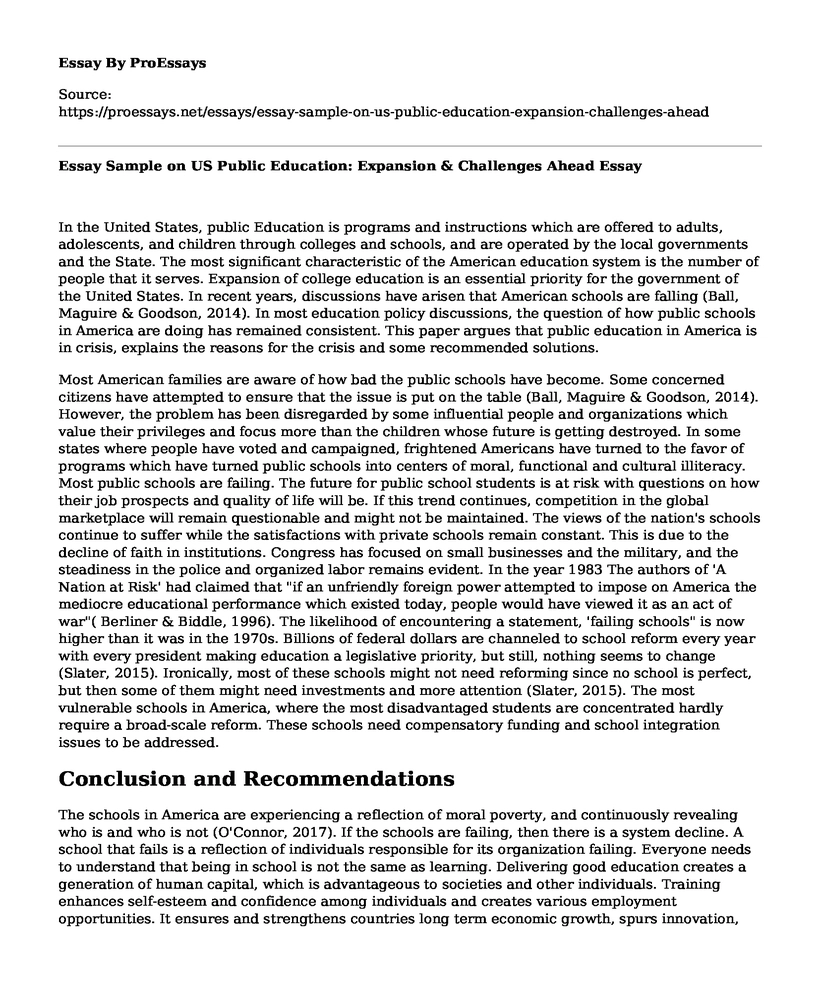In the United States, public Education is programs and instructions which are offered to adults, adolescents, and children through colleges and schools, and are operated by the local governments and the State. The most significant characteristic of the American education system is the number of people that it serves. Expansion of college education is an essential priority for the government of the United States. In recent years, discussions have arisen that American schools are falling (Ball, Maguire & Goodson, 2014). In most education policy discussions, the question of how public schools in America are doing has remained consistent. This paper argues that public education in America is in crisis, explains the reasons for the crisis and some recommended solutions.
Most American families are aware of how bad the public schools have become. Some concerned citizens have attempted to ensure that the issue is put on the table (Ball, Maguire & Goodson, 2014). However, the problem has been disregarded by some influential people and organizations which value their privileges and focus more than the children whose future is getting destroyed. In some states where people have voted and campaigned, frightened Americans have turned to the favor of programs which have turned public schools into centers of moral, functional and cultural illiteracy. Most public schools are failing. The future for public school students is at risk with questions on how their job prospects and quality of life will be. If this trend continues, competition in the global marketplace will remain questionable and might not be maintained. The views of the nation's schools continue to suffer while the satisfactions with private schools remain constant. This is due to the decline of faith in institutions. Congress has focused on small businesses and the military, and the steadiness in the police and organized labor remains evident. In the year 1983 The authors of 'A Nation at Risk' had claimed that "if an unfriendly foreign power attempted to impose on America the mediocre educational performance which existed today, people would have viewed it as an act of war"( Berliner & Biddle, 1996). The likelihood of encountering a statement, 'failing schools" is now higher than it was in the 1970s. Billions of federal dollars are channeled to school reform every year with every president making education a legislative priority, but still, nothing seems to change (Slater, 2015). Ironically, most of these schools might not need reforming since no school is perfect, but then some of them might need investments and more attention (Slater, 2015). The most vulnerable schools in America, where the most disadvantaged students are concentrated hardly require a broad-scale reform. These schools need compensatory funding and school integration issues to be addressed.
Conclusion and Recommendations
The schools in America are experiencing a reflection of moral poverty, and continuously revealing who is and who is not (O'Connor, 2017). If the schools are failing, then there is a system decline. A school that fails is a reflection of individuals responsible for its organization failing. Everyone needs to understand that being in school is not the same as learning. Delivering good education creates a generation of human capital, which is advantageous to societies and other individuals. Training enhances self-esteem and confidence among individuals and creates various employment opportunities. It ensures and strengthens countries long term economic growth, spurs innovation, and reduces poverty. For changes in public schools, students will need good teachers. A learning crisis is a teaching crisis. Teachers in public schools need to be equipped and motivated in doing their best so that they can teach effectively. Learners need something that they can believe in, and the best teachers, bring out the best in their students. Those managing the public schools should be held accountable and should have proven records of success, accountability, leadership, and community involvement. In addition to these, influential people, the President, and the Congress need to make the issue a priority, and parents should take stands and address the problems their children are facing.
References
Ball, S., Maguire, M., & Goodson, I. (Eds.). (2014). Education, capitalism, and the global crisis. Routledge. Retrieved fromhttps://www.ebooks.com/en-us/1743966/education-capitalism-and-the-global-crisis/stephen-ball-meg-maguire-ivor-goodson/
Berliner, D. C., & Biddle, B. J. (1996). The manufactured crisis: Myths, fraud, and the attack on America's public schools. Nassp Bulletin, 80(576), 119-121. Retrieved fromhttps://static1.squarespace.com/static/55e72334e4b004a111a82a59/t/56a163401a5203f60ef8c6e8/1453417291700/The%2BManufactured%2BCrisis.pdf
O'Connor, J. (2017). The fiscal crisis of the state. Routledge. Retrieved fromhttps://www.amazon.com/Fiscal-Crisis-State-James-OConnor/dp/1138535664
Slater, G. B. (2015). Education as recovery: Neoliberalism, school reform, and the politics of crisis. Journal of education policy, 30(1), 1-20.Retrieved from https://www.tandfonline.com/doi/abs/10.1080/02680939.2014.904930
Cite this page
Essay Sample on US Public Education: Expansion & Challenges Ahead. (2023, Jan 29). Retrieved from https://proessays.net/essays/essay-sample-on-us-public-education-expansion-challenges-ahead
If you are the original author of this essay and no longer wish to have it published on the ProEssays website, please click below to request its removal:
- Health Disparities in Mississippi Essay
- Essay Example on Immigrants in US: Benefits & Impact on Labor Force
- Essay Example on Living Constitution: Preservation of U.S Constitution.
- Essay on Comedy to Seriousness: My Unexpected Reaction to a Friend's Joke
- Essay on 1800s US Presidential Election: John Adams vs Thomas Jefferson
- Early Childhood Education: A Critical Process for Society - Essay Sample
- Agape and Philautia: Symbiosis or Parasitism?







